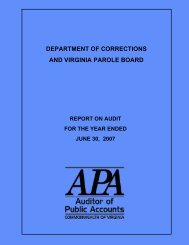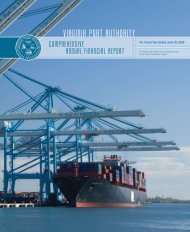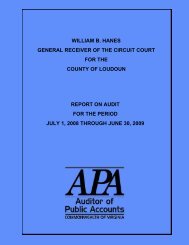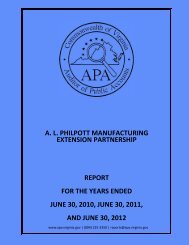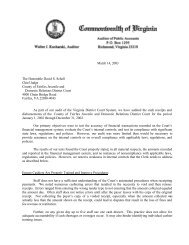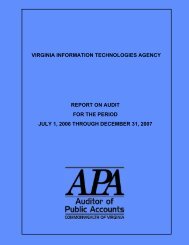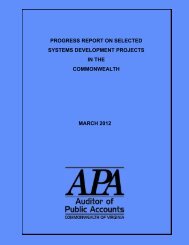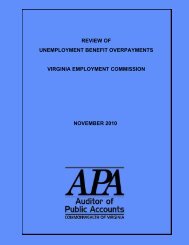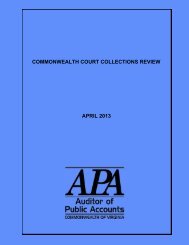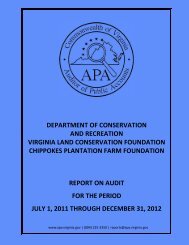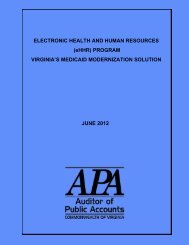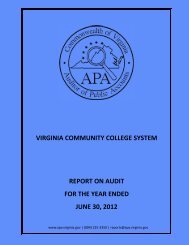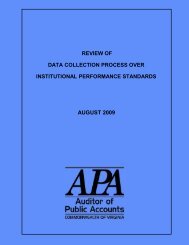Virginia Employment Commission for the year ended June 30, 2010
Virginia Employment Commission for the year ended June 30, 2010
Virginia Employment Commission for the year ended June 30, 2010
Create successful ePaper yourself
Turn your PDF publications into a flip-book with our unique Google optimized e-Paper software.
VIRGINIA EMPLOYMENT COMMISSION<br />
REPORT ON AUDIT<br />
FOR THE YEAR ENDED<br />
JUNE <strong>30</strong>, <strong>2010</strong>
AUDIT SUMMARY<br />
Our audit of <strong>the</strong> <strong>Virginia</strong> <strong>Employment</strong> <strong>Commission</strong> <strong>for</strong> <strong>the</strong> <strong>year</strong> <strong>ended</strong> <strong>June</strong> <strong>30</strong>, <strong>2010</strong>, found<br />
<strong>the</strong> following:<br />
<br />
<br />
<br />
proper recording and reporting of transactions, in all material respects, in<br />
<strong>the</strong> Commonwealth Accounting and Reporting System and in <strong>the</strong><br />
<strong>Employment</strong> <strong>Commission</strong>’s Tax and Benefits Systems;<br />
an internal control matter that requires management’s attention and corrective<br />
action; and<br />
no instances of noncompliance with applicable laws and regulations or<br />
o<strong>the</strong>r matters that are required to be reported.<br />
As part of our audit, we per<strong>for</strong>med additional work related to unemployment benefit<br />
overpayment to address a legislative request we received in February <strong>2010</strong>. We issued a separate<br />
report on this work in December <strong>2010</strong> entitled “Review of Unemployment Benefit Overpayments,<br />
<strong>Virginia</strong> <strong>Employment</strong> <strong>Commission</strong>.”
– T A B L E O F C O N T E N T S –<br />
Pages<br />
AUDIT SUMMARY<br />
FINDING AND RECOMMENDATION 1<br />
AGENCY BACKGROUND AND FINANCIAL INFORMATION 2-7<br />
Unemployment Insurance Services 3-5<br />
Discussion of Issues Impacting Future Years 6-7<br />
INDEPENDENT AUDITOR’S REPORT 8-9<br />
AGENCY RESPONSE 10<br />
OFFICIALS PAGE 11
FINDING AND RECOMMENDATION<br />
Streng<strong>the</strong>n Controls Over System Access<br />
FOLLOW-UP ON PRIOR AUDIT FINDING<br />
The <strong>Employment</strong> <strong>Commission</strong> should continue to streng<strong>the</strong>n procedures <strong>for</strong> granting and<br />
monitoring access to <strong>the</strong> <strong>Virginia</strong> Automated Benefit System (VABS) and <strong>the</strong> <strong>Virginia</strong> Automated<br />
Tax System (VATS). We identified this issue in our prior report and since <strong>the</strong>n <strong>the</strong> <strong>Employment</strong><br />
<strong>Commission</strong> has implemented a new Access Control Verification system to help managers review<br />
and monitor system access; however, <strong>the</strong> following issues remain:<br />
<br />
<br />
<br />
The <strong>Employment</strong> <strong>Commission</strong> does not have written procedures to document who has <strong>the</strong><br />
authorization to grant access or <strong>the</strong> process required <strong>for</strong> granting access.<br />
The Automated System Access Request (ASAR) <strong>for</strong>m documents system access requests,<br />
but it does not clearly identify which level of access users receive. The <strong>for</strong>m is outdated<br />
and does not reflect <strong>the</strong> current operating environment.<br />
According to <strong>the</strong>ir policy, <strong>the</strong> <strong>Employment</strong> <strong>Commission</strong> conducts a semi-annual<br />
management review of VATS and VABS access. They conducted <strong>the</strong>ir first review using<br />
<strong>the</strong> new system in May <strong>2010</strong>; however, <strong>the</strong>re is no way to tell if managers completed<br />
<strong>the</strong>ir review timely. In addition, as of <strong>June</strong> 1, <strong>2010</strong>, <strong>the</strong>re were 35 managers who had not<br />
completed <strong>the</strong>ir review.<br />
VATS and VABS both contain sensitive in<strong>for</strong>mation; <strong>the</strong>re<strong>for</strong>e it is critical that only<br />
authorized <strong>Employment</strong> <strong>Commission</strong> staff have access to <strong>the</strong>se systems. We recommend <strong>the</strong><br />
<strong>Employment</strong> <strong>Commission</strong> update, implement, and follow policies and procedures over granting and<br />
monitoring system access to VATS and VABS. This should include a review of <strong>the</strong> ASAR <strong>for</strong>m to<br />
ensure it is up to date and reflects <strong>the</strong> current operating environment.<br />
1
AGENCY BACKGROUND AND FINANCIAL INFORMATION<br />
The <strong>Employment</strong> <strong>Commission</strong>’s mission is to promote economic growth and stability by<br />
delivering and coordinating work<strong>for</strong>ce services that include job placement services, temporary<br />
income support, work<strong>for</strong>ce in<strong>for</strong>mation, and transition and training services. The <strong>Employment</strong><br />
<strong>Commission</strong> has nearly 1,<strong>30</strong>0 employees working at various offices throughout <strong>Virginia</strong>. Of <strong>the</strong>se<br />
employees, approximately 450 are temporary wage employees.<br />
The <strong>Employment</strong> <strong>Commission</strong> funding comes primarily from unemployment taxes collected<br />
from employers, which go into <strong>the</strong> Unemployment Trust Fund, which we discuss in more detail later<br />
in this report. The <strong>Employment</strong> <strong>Commission</strong> also receives some federal grants used primarily to<br />
fund administrative activities.<br />
In fiscal <strong>year</strong> <strong>2010</strong>, <strong>the</strong> <strong>Employment</strong> <strong>Commission</strong> also received federal stimulus funds under<br />
<strong>the</strong> American Recovery and Reinvestment Act of 2009. These federal funds paid <strong>for</strong> unemployment<br />
benefit extensions approved by <strong>the</strong> federal government of approximately $646 million in fiscal <strong>year</strong><br />
<strong>2010</strong>. Some of <strong>the</strong>se funds also paid administrative expenses.<br />
The <strong>Employment</strong> <strong>Commission</strong> budgets its funding in two programs: Work<strong>for</strong>ce Systems<br />
Services and Economic Development Services. The Work<strong>for</strong>ce Systems Services program is <strong>the</strong><br />
<strong>Commission</strong>’s primary program, as shown in <strong>the</strong> following table of budget and actual activity <strong>for</strong><br />
fiscal <strong>year</strong> <strong>2010</strong>. For purposes of this table, we present <strong>the</strong> Work<strong>for</strong>ce Systems Services program by<br />
service area to provide more detailed in<strong>for</strong>mation on what makes up this program. The Job<br />
Placement Services area in <strong>the</strong> chart below has a negative final budget. This occurred because <strong>the</strong><br />
<strong>Employment</strong> <strong>Commission</strong> recorded a $50 million budget adjustment in <strong>the</strong> wrong service area,<br />
which both <strong>the</strong> <strong>Employment</strong> <strong>Commission</strong> and <strong>the</strong> Department of Planning and Budget did not detect.<br />
This coding error did not adversely affect <strong>the</strong> operations of <strong>the</strong> <strong>Employment</strong> <strong>Commission</strong>.<br />
Budget and Actual Activity <strong>for</strong> Fiscal Year <strong>2010</strong><br />
Program and Service Area Original Budget Final Budget Expenses<br />
Work<strong>for</strong>ce Systems Services:<br />
Job Placement Services $ 37,376,662 $ (5,418,581) $ 34,793,626<br />
Unemployment Insurance Services 907,785,648 2,361,800,404 1,998,436,357<br />
Work<strong>for</strong>ce Development Services 5,400,000 5,400,000 1,652,663<br />
Economic Development Services 3,258,552 3,258,552 2,684,069<br />
Total $953,820,862 $2,365,040,375 $2,037,566,715<br />
The largest of <strong>the</strong>se program service areas is <strong>the</strong> Unemployment Insurance Services, under<br />
which <strong>the</strong> <strong>Employment</strong> <strong>Commission</strong> makes benefit payments to unemployed workers. The budget<br />
and expenses increased significantly due to high levels of unemployment, causing <strong>the</strong> significant<br />
increases in benefits. The report discusses <strong>the</strong> Unemployment Insurance Services program below.<br />
2
Unemployment Insurance Services<br />
Under <strong>the</strong> Unemployment Insurance Services program, <strong>the</strong> <strong>Employment</strong> <strong>Commission</strong> makes<br />
unemployment benefit payments to unemployed workers who lost <strong>the</strong>ir employment through no fault<br />
of <strong>the</strong>ir own. The unemployment benefit payments provide workers with minimal income during <strong>the</strong><br />
course of a job search. Generally, <strong>the</strong> amount and length of benefits an individual is eligible <strong>for</strong> is<br />
based on wages an individual earned while employed. The Governor and <strong>the</strong> General Assembly<br />
have <strong>the</strong> ability to adjust unemployment benefit payments and <strong>the</strong> following is a history of minimum<br />
and maximum weekly benefit amounts since 2003.<br />
Minimum<br />
Benefit<br />
Maximum<br />
Benefit<br />
July 6, 2003 - July 3, 2004 $50 $316<br />
July 4, 2004 - July 2, 2005 $50 $326<br />
July 3, 2005 - July 2, 2006 $54 $3<strong>30</strong><br />
July 3, 2006 – <strong>June</strong> <strong>30</strong>, 2007 $54 $347<br />
July 1, 2007 – July 5, 2008 $54 $363<br />
July 6, 2008 - Present $54 $378<br />
The <strong>Employment</strong> <strong>Commission</strong> pays unemployment insurance benefit payments from<br />
unemployment taxes collected from Commonwealth employers if <strong>the</strong> employer meets certain criteria<br />
set <strong>for</strong>th in <strong>the</strong> Code of <strong>Virginia</strong>. Under current law, employers pay taxes only on <strong>the</strong> first $8,000 of<br />
each employee’s wages. The <strong>Employment</strong> <strong>Commission</strong> collects <strong>the</strong>se taxes throughout <strong>the</strong> <strong>year</strong> and<br />
transfers <strong>the</strong> amount collected to <strong>the</strong> federal government, which maintains <strong>the</strong> Federal<br />
Unemployment Trust Fund (Trust Fund). The <strong>Employment</strong> <strong>Commission</strong> is <strong>the</strong> trustee and uses <strong>the</strong><br />
fund to pay State unemployment insurance benefit payments.<br />
Generally, in times of low unemployment, <strong>the</strong> Trust Fund builds up a balance to pay benefits<br />
in times of higher unemployment. The unemployment rate has been increasing significantly over <strong>the</strong><br />
last several <strong>year</strong>s as shown below. The increasing unemployment rate and <strong>the</strong> impact of this on<br />
benefits paid, taxes collected, and <strong>the</strong> trust fund balance are in <strong>the</strong> chart on <strong>the</strong> following page.<br />
Fiscal<br />
Year<br />
Unemployment<br />
Rate<br />
2002 4.00%<br />
2003 4.20%<br />
2004 3.90%<br />
2005 3.60%<br />
2006 3.20%<br />
2007 3.00%<br />
2008 3.<strong>30</strong>%<br />
2009 5.60%<br />
<strong>2010</strong> 7.00%<br />
3
Summary of Unemployment Trust Fund Activity (fiscal <strong>year</strong> 2002 – <strong>2010</strong>)<br />
$1,000,000,000<br />
$800,000,000<br />
$600,000,000<br />
$400,000,000<br />
$200,000,000<br />
Tax Receipts Collected<br />
State Benefits Paid<br />
Trust Fund Balance<br />
$0<br />
-$200,000,000<br />
Note: The fiscal <strong>year</strong> <strong>2010</strong> Trust Fund balance is net of any borrowed funds.<br />
Trust Fund Balance as <strong>June</strong> <strong>30</strong>, <strong>2010</strong><br />
The Trust Fund balance has decreased significantly over <strong>the</strong> last several <strong>year</strong>s due to increased<br />
unemployed recipients causing <strong>the</strong> increased volume of unemployment benefits. During fiscal <strong>year</strong><br />
<strong>2010</strong>, <strong>the</strong> <strong>Employment</strong> <strong>Commission</strong> had to pay more in benefits than <strong>the</strong> Trust Fund contained.<br />
There<strong>for</strong>e, <strong>the</strong> Trust Fund had a deficit.<br />
When <strong>the</strong> Trust Fund incurs a deficit, Section 1201 of <strong>the</strong> Social Security Act (Act) provides <strong>for</strong><br />
temporary loans from <strong>the</strong> federal government to ensure <strong>the</strong> continuation of benefit payments. The Act<br />
requires repayment of any loans from future employer contributions, but does not allow <strong>the</strong> <strong>Employment</strong><br />
<strong>Commission</strong> to use employer contributions to pay any interest owed on <strong>the</strong> outstanding loan balance.<br />
The <strong>Employment</strong> <strong>Commission</strong> began borrowing from <strong>the</strong> federal government in October, 2009.<br />
The process <strong>for</strong> obtaining a loan begins when <strong>the</strong> <strong>Employment</strong> <strong>Commission</strong>, with <strong>the</strong> approval of <strong>the</strong><br />
Governor, requests a loan from <strong>the</strong> United States Secretary of Labor within 15 days of <strong>the</strong> needed<br />
funding. The Secretary of Labor <strong>the</strong>n authorizes <strong>the</strong> establishment of a line of credit, which <strong>the</strong><br />
<strong>Employment</strong> <strong>Commission</strong> has to request each quarter. The <strong>Employment</strong> <strong>Commission</strong> does not incur a<br />
penalty <strong>for</strong> requesting a larger line of credit than it needs.<br />
As of <strong>June</strong> <strong>30</strong>, <strong>2010</strong>, <strong>the</strong> <strong>Employment</strong> <strong>Commission</strong> had borrowed $346,876,000 and <strong>the</strong> balance<br />
in <strong>the</strong> Trust Fund was approximately $217 million. Most of <strong>the</strong> balance on hand at <strong>the</strong> end of <strong>the</strong> <strong>year</strong> is<br />
from quarterly employer tax collections because <strong>the</strong> amount borrowed was already used to pay benefits<br />
during <strong>the</strong> <strong>year</strong>.<br />
4
Trust Fund Solvency and Tax Rate<br />
Trust fund solvency is an indicator of <strong>the</strong> fund’s ability to pay benefits during periods of high<br />
unemployment. The solvency indicator compares <strong>the</strong> fund’s actual balance to <strong>the</strong> calculated balance<br />
needed to pay <strong>the</strong>se benefits <strong>for</strong> 16.5 months. The <strong>Employment</strong> <strong>Commission</strong> computed <strong>the</strong> trust<br />
fund solvency factor <strong>for</strong> calendar <strong>year</strong> <strong>2010</strong> to be 24.4 percent. This is a significant decrease from<br />
2009 when it was 64.4 percent. The <strong>Employment</strong> <strong>Commission</strong> anticipates, due to <strong>the</strong> required<br />
borrowing of federal funds, that <strong>the</strong> trust fund solvency factor <strong>for</strong> calendar <strong>year</strong> 2011 will be<br />
negative.<br />
The Trust Fund’s solvency rate has an inverse relationship to employer tax rates, meaning, as<br />
<strong>the</strong> solvency decreases, <strong>the</strong> unemployment tax rates generally increase. When <strong>the</strong> Trust Fund<br />
solvency remains at or above 100 percent, state law sets <strong>the</strong> lowest tax rate at zero. If <strong>the</strong> solvency<br />
rate falls below 100 percent, all required employers must pay unemployment tax. The tax rates<br />
imposed on employers take into account <strong>the</strong> solvency rate as well as <strong>the</strong> employment histories of<br />
individual businesses. Generally, employers with a history of higher unemployment claims pay a<br />
greater rate, while those with fewer claims pay less or nothing at all.<br />
State law requires additional adjustments to <strong>the</strong> tax rate when trust fund solvency declines.<br />
The pool tax is an adjustment to <strong>the</strong> tax rate that represents a levy to recover benefits not chargeable<br />
to a specific employer, known as pool costs. When trust fund solvency exceeds 50 percent, interest<br />
income from <strong>the</strong> Trust Fund offsets pool costs; however, <strong>the</strong> <strong>Employment</strong> <strong>Commission</strong> adds <strong>the</strong> pool<br />
tax to <strong>the</strong> tax rate when interest income does not cover pool costs. In addition, state law requires a<br />
fund-building tax rate of 0.2 percent increase to employer tax rates if <strong>the</strong> Trust Fund balance drops<br />
below 50 percent.<br />
The following table details <strong>the</strong> various tax rate components in effect <strong>for</strong> calendar <strong>year</strong>s 2008,<br />
2009, and <strong>2010</strong>. The <strong>Employment</strong> <strong>Commission</strong> will calculate and publish <strong>the</strong> calendar <strong>year</strong> 2011<br />
tax rates in December of <strong>2010</strong>. As result, <strong>the</strong>se are not included in our table below.<br />
Calendar Year 2008<br />
Tax Rates<br />
Calendar Year 2009<br />
Tax Rates<br />
Calendar Year <strong>2010</strong><br />
Tax Rates<br />
Minimum Maximum Minimum Maximum Minimum Maximum<br />
Tax rate 0.10% 6.20% 0.10% 6.20% 0.10% 6.20%<br />
Pool tax 0.02% 0.02% 0.08% 0.08% 0.28% 0.28%<br />
Fund-building tax - - - - 0.20% 0.20%<br />
Total 0.12% 6.22% 0.18% 6.28% 0.58% 6.68%<br />
5
Discussion of Issues Impacting Future Years<br />
There are a number of factors that are going to continue to significantly affect <strong>the</strong><br />
<strong>Employment</strong> <strong>Commission</strong>’s programs in fiscal <strong>year</strong> 2011 and beyond, and we discuss <strong>the</strong>se issues<br />
below.<br />
Trust Fund Borrowing and Repayment<br />
Continuing high unemployment levels in <strong>Virginia</strong> will result in <strong>the</strong> need to continue to borrow<br />
money from <strong>the</strong> federal government to pay unemployment benefits. The <strong>Employment</strong> <strong>Commission</strong><br />
expects it will need to borrow an additional $613 million at various times through fiscal <strong>year</strong> 2013<br />
with <strong>the</strong> total amount borrowed equaling $960 million by <strong>the</strong> spring of 2013.<br />
The federal government has waived interest payments on money borrowed though December<br />
<strong>2010</strong>; however, <strong>the</strong> <strong>Employment</strong> <strong>Commission</strong> will begin to accrue interest on <strong>the</strong> money borrowed<br />
starting on January 1, 2011 unless <strong>the</strong> federal government extends <strong>the</strong> suspension of interest payments.<br />
Currently, <strong>the</strong> first interest payment will be due September <strong>30</strong>, 2011 and <strong>the</strong> <strong>Employment</strong><br />
<strong>Commission</strong> estimates interest payments will be $11.9 million due in fiscal <strong>year</strong> 2012 and $8.3<br />
million due in fiscal <strong>year</strong> 2013.<br />
As discussed above, <strong>the</strong> <strong>Employment</strong> <strong>Commission</strong> cannot use employer contributions to pay<br />
interest on any outstanding loan balance; <strong>the</strong>re<strong>for</strong>e, <strong>the</strong> <strong>Employment</strong> <strong>Commission</strong> will need to determine<br />
alternative funding sources to repay <strong>the</strong> interest. Appropriation Act Chapter 874 of <strong>the</strong> <strong>2010</strong> <strong>Virginia</strong><br />
Acts of Assembly requires <strong>the</strong> <strong>Employment</strong> <strong>Commission</strong> use penalties and interest, recorded in <strong>the</strong><br />
Special Unemployment Compensation Administration Fund, to pay <strong>the</strong> interest to <strong>the</strong> federal<br />
government on loans <strong>for</strong> <strong>the</strong> Unemployment Insurance Fund be<strong>for</strong>e using <strong>the</strong>se funds <strong>for</strong> o<strong>the</strong>r<br />
functions. While this is a potential funding source, it may not be sufficient to pay all of <strong>the</strong><br />
interest and this may impact funding <strong>for</strong> system development projects discussed below.<br />
Additionally, as <strong>the</strong> loans begin to accrue interest, <strong>the</strong> <strong>Employment</strong> <strong>Commission</strong> plans to<br />
begin using all remaining employer contributions at <strong>the</strong> end of each quarter to repay <strong>the</strong> loans. The<br />
<strong>Employment</strong> <strong>Commission</strong> estimates <strong>the</strong>y will have <strong>the</strong> loans paid back in full by May 2012, but <strong>the</strong>y<br />
also anticipate additional short term borrowing through <strong>the</strong> Spring 2013. A number of different<br />
factors including changes in <strong>the</strong> economic conditions, <strong>the</strong> unemployment rates, and any additional<br />
actions taken by <strong>the</strong> federal government can impact <strong>the</strong>se projections.<br />
System Development Projects<br />
The <strong>Employment</strong> <strong>Commission</strong> has two system development initiatives that will replace<br />
multiple outdated systems over <strong>the</strong> next several <strong>year</strong>s, <strong>the</strong> Financial Management Systems Project<br />
and <strong>the</strong> Unemployment Insurance Modernization Project (UI Mod).<br />
The Financial Management Systems project is a modern, integrated financial management<br />
system to replace <strong>the</strong>ir outdated mainframe batch system. The <strong>Employment</strong> <strong>Commission</strong> plans to<br />
procure an off-<strong>the</strong>-shelf solution and modify it to meet both <strong>the</strong> needs of <strong>the</strong> Commonwealth and <strong>the</strong><br />
Department of Labor (DOL) requirements. The <strong>Employment</strong> <strong>Commission</strong> has completed <strong>the</strong><br />
6
equest <strong>for</strong> proposal process and identified <strong>the</strong> top vendor <strong>for</strong> <strong>the</strong> project; however, <strong>the</strong> <strong>Employment</strong><br />
<strong>Commission</strong> has not signed a <strong>for</strong>mal contract with <strong>the</strong> vendor. VITA approved <strong>the</strong> project planning,<br />
however <strong>the</strong> <strong>Employment</strong> <strong>Commission</strong> has not received VITA development approval due to <strong>the</strong> risk<br />
identified below. The total cost of <strong>the</strong> project is $4.7 million and will span approximately 18<br />
months.<br />
In addition to <strong>the</strong> Financial Management System project, <strong>the</strong> <strong>Employment</strong> <strong>Commission</strong> is in<br />
<strong>the</strong> process of developing an Unemployment Insurance (UI) system, which will replace VATS,<br />
VABS, and <strong>the</strong> Wage Record System. This system development initiative, UI Mod, will support<br />
payment of UI Benefits to unemployed workers, collection of UI Taxes from employers, and <strong>the</strong><br />
accumulation of wage data.<br />
The total budget <strong>for</strong> UI Mod is $58.5 million with $49.1 million coming from <strong>the</strong> Reed Act<br />
funds and <strong>the</strong> remaining $9.4 million coming from <strong>the</strong> <strong>Employment</strong> <strong>Commission</strong>s penalty and<br />
interest fund. The <strong>Employment</strong> <strong>Commission</strong> is in <strong>the</strong> development stages of <strong>the</strong> project and<br />
completion of <strong>the</strong> UI Mod project is to occur in <strong>June</strong> of 2013.<br />
There are two issues that could affect <strong>the</strong> scope and success of <strong>the</strong>se projects. Both project<br />
plans include partial funding from penalties and interest collected by <strong>the</strong> <strong>Employment</strong><br />
<strong>Commission</strong>; however, it is not clear if <strong>the</strong>se funds will be available. The Financial Management<br />
System project plan includes $1.5 million in penalties and interest funding while <strong>the</strong> UI Mod<br />
project plans includes $9.4 million. The Appropriation Act Chapter 874 of <strong>the</strong> <strong>2010</strong> <strong>Virginia</strong> Acts<br />
of Assembly requires <strong>the</strong> <strong>Employment</strong> <strong>Commission</strong> first use penalties and interest to repay federal<br />
loan interest as discussed earlier. The <strong>Employment</strong> <strong>Commission</strong> has not yet determined how <strong>the</strong>y<br />
will repay <strong>the</strong> federal loan interest, but it is possible that this could impact funding available <strong>for</strong><br />
<strong>the</strong>se system development projects.<br />
In addition, <strong>the</strong> <strong>Employment</strong> <strong>Commission</strong> and VITA have not come to an agreement on<br />
where <strong>the</strong> production environment <strong>for</strong> both <strong>the</strong> UI Mod and <strong>the</strong> Financial Management System<br />
will reside once <strong>the</strong> project is completed. This decision will potentially affect <strong>the</strong> budget <strong>for</strong> both<br />
projects because <strong>the</strong> <strong>Employment</strong> <strong>Commission</strong> did not factor <strong>the</strong> additional VITA costs into <strong>the</strong><br />
current budgets. In addition, without an agreement on <strong>the</strong> hosting environment, <strong>the</strong> <strong>Employment</strong><br />
<strong>Commission</strong> will not receive VITA development approval <strong>for</strong> <strong>the</strong> Financial Management System.<br />
7
November 15, <strong>2010</strong><br />
The Honorable Robert F. McDonnell<br />
Governor of <strong>Virginia</strong><br />
The Honorable Charles J. Colgan<br />
Chairman, Joint Legislative Audit<br />
and Review <strong>Commission</strong><br />
INDEPENDENT AUDITOR’S REPORT<br />
We have audited <strong>the</strong> financial records and operations of <strong>the</strong> <strong>Virginia</strong> <strong>Employment</strong><br />
<strong>Commission</strong> <strong>for</strong> <strong>the</strong> <strong>year</strong> <strong>ended</strong> <strong>June</strong> <strong>30</strong>, <strong>2010</strong>. We conducted this per<strong>for</strong>mance audit in accordance<br />
with generally accepted government auditing standards. Those standards require that we plan and<br />
per<strong>for</strong>m <strong>the</strong> audit to obtain sufficient, appropriate evidence to provide a reasonable basis <strong>for</strong> our<br />
findings and conclusions based on our audit objectives. We believe that <strong>the</strong> evidence obtained<br />
provides a reasonable basis <strong>for</strong> our findings and conclusions based on our audit objectives.<br />
Audit Objectives<br />
Our audit’s primary objective was to evaluate <strong>the</strong> accuracy of <strong>the</strong> <strong>Virginia</strong> <strong>Employment</strong><br />
<strong>Commission</strong>’s financial transactions as reported in <strong>the</strong> Comprehensive Annual Financial Report <strong>for</strong><br />
<strong>the</strong> Commonwealth of <strong>Virginia</strong> <strong>for</strong> <strong>the</strong> <strong>year</strong> <strong>ended</strong> <strong>June</strong> <strong>30</strong>, <strong>2010</strong>, and test compliance <strong>for</strong> <strong>the</strong><br />
Statewide Single Audit. In support of this objective, we evaluated <strong>the</strong> accuracy of recording<br />
financial transactions on <strong>the</strong> Commonwealth Accounting and Reporting System and in <strong>the</strong><br />
<strong>Employment</strong> <strong>Commission</strong>’s Tax and Benefits Systems, reviewed <strong>the</strong> adequacy of <strong>the</strong> <strong>Employment</strong><br />
<strong>Commission</strong>’s internal control, tested <strong>for</strong> compliance with applicable laws, regulations, contracts,<br />
and grant agreements, and reviewed corrective actions of audit findings from prior <strong>year</strong> reports.<br />
Audit Scope and Methodology<br />
The <strong>Employment</strong> <strong>Commission</strong>’s management has responsibility <strong>for</strong> establishing and<br />
maintaining internal control and complying with applicable laws and regulations. Internal control is<br />
a process designed to provide reasonable, but not absolute, assurance regarding <strong>the</strong> reliability of<br />
financial reporting, effectiveness and efficiency of operations, and compliance with applicable laws<br />
and regulations.<br />
8
We gained an understanding of <strong>the</strong> overall internal controls, automated and manual,<br />
sufficient to plan <strong>the</strong> audit. We considered materiality and risk in determining <strong>the</strong> nature and extent<br />
of our audit procedures. Our review encompassed controls over <strong>the</strong> following significant cycles,<br />
classes of transactions, and account balances.<br />
Unemployment Benefit Payments<br />
Taxes and Cash Receipts<br />
Federal Grants Revenue and Expenses<br />
In<strong>for</strong>mation Security<br />
Accounts Receivable<br />
Accounts Payable<br />
We per<strong>for</strong>med audit tests we deemed necessary to determine whe<strong>the</strong>r <strong>the</strong> <strong>Employment</strong><br />
<strong>Commission</strong>’s controls were adequate, had been placed in operation, and were being followed. Our<br />
audit also included tests of compliance with provisions of applicable laws and regulations. Our audit<br />
procedures included inquiries of appropriate personnel, inspection of documents, records, and<br />
contracts, and observation of <strong>the</strong> <strong>Employment</strong> <strong>Commission</strong>’s operations. We tested transactions and<br />
per<strong>for</strong>med analytical procedures, including budgetary and trend analyses.<br />
Conclusions<br />
We found that <strong>the</strong> <strong>Employment</strong> <strong>Commission</strong> properly stated, in all material respects, <strong>the</strong><br />
amounts recorded and reported in <strong>the</strong> Commonwealth Accounting and Reporting System and in <strong>the</strong><br />
<strong>Employment</strong> <strong>Commission</strong>’s Tax and Benefit Systems. The <strong>Employment</strong> <strong>Commission</strong> records its<br />
financial transactions on <strong>the</strong> cash basis of accounting, which is a comprehensive basis of accounting<br />
o<strong>the</strong>r than accounting principles generally accepted in <strong>the</strong> United States of America. The financial<br />
in<strong>for</strong>mation presented in this report came directly from <strong>the</strong> Commonwealth Accounting and<br />
Reporting System and <strong>the</strong> <strong>Employment</strong> <strong>Commission</strong>’s Tax and Benefit Systems.<br />
We noted a certain matter involving internal control and its operation that requires<br />
management’s attention and corrective action. This matter is described in <strong>the</strong> section entitled,<br />
“Finding and Recommendation.” The results of our tests of compliance with applicable laws and<br />
regulations disclosed no instances of noncompliance or o<strong>the</strong>r matters that are required to be reported<br />
under Government Auditing Standards.<br />
The <strong>Employment</strong> <strong>Commission</strong> has taken adequate corrective action on prior <strong>year</strong> findings,<br />
but has not completely resolved <strong>the</strong> prior finding “Streng<strong>the</strong>n Controls over Systems Access.” This<br />
is discussed in <strong>the</strong> section entitled “Finding and Recommendation.”<br />
Exit Conference and Report Distribution<br />
We discussed this letter with management on November 22, <strong>2010</strong>. Management’s response<br />
has been included at <strong>the</strong> end of this report.<br />
This report is int<strong>ended</strong> <strong>for</strong> <strong>the</strong> in<strong>for</strong>mation and use of <strong>the</strong> Governor and General Assembly,<br />
management, and citizens of <strong>the</strong> Commonwealth of <strong>Virginia</strong> and is a public record.<br />
LCW/clj<br />
AUDITOR OF PUBLIC ACCOUNTS<br />
9
VIRGINIA EMPLOYMENT COMMISSION<br />
John Broadway<br />
<strong>Commission</strong>er<br />
Dr. Robert P. Leber<br />
Deputy <strong>Commission</strong>er<br />
11



